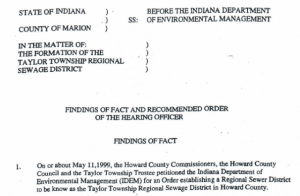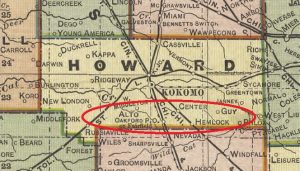Why was the Taylor Regional Sewer District Formed in the first place?
The formation of the Taylor Regional Sewer District (TRSD) in 1999 was a critical response to significant public health and environmental concerns in the Howard County communities of Center, Hemlock, and Oakford, Indiana. Faced with widespread failing septic systems and compromised water quality, local authorities, including the Howard County Commissioners, the Howard County Council, and the Taylor Township Trustee, petitioned the Indiana Department of Environmental Management (IDEM) for the establishment of a regional sewer district. This move was not arbitrary but rather a strategic and often necessary measure to provide essential wastewater infrastructure in small and rural communities.

Failing Septic Tanks Lead to Ground Water Contamination
Prior to the TRSD’s formation, residents in these areas relied heavily on private septic tanks for sewage disposal. Over time, many of these systems began to fail, leading to untreated wastewater seeping into the ground and, consequently, contaminating private drinking water wells. This created a serious public health risk and significant environmental degradation. The absence of any public or privately owned treatment works capable of addressing sanitary sewage in the affected areas further exacerbated the problem, hindering residents’ ability to alleviate these environmental concerns independently.

The IDEM’s “Findings of Fact and Recommended Order” from August 15, 2000, clearly outlined the pressing need for the TRSD. It recognized that the ability of residents to resolve the environmental issues caused by failing septic systems was “inhibited” without a centralized solution. The primary purpose of the newly formed district was unequivocally defined: to provide for the collection, treatment, and disposal of sewage within the proposed district’s boundaries. This approach aimed to replace the inadequate individual septic systems with collective community infrastructure.
Regional sewer districts like the TRSD serve as a common and highly cost-effective tool for addressing such challenges in smaller and more rural settings. Unlike individual septic systems, which require ongoing maintenance and are prone to failure, a centralized sewer system offers a more reliable and sustainable long-term solution. By pooling resources and spreading the cost of infrastructure development and maintenance across a broader user base, regional districts can achieve economies of scale that would be impossible for individual households or smaller, fragmented initiatives.
Sewer District Funding and Ongoing Financial Viability
The funding model for the TRSD exemplifies this collaborative and economically feasible approach. The project was planned to receive financial support from a combination of sources, including the Indiana Department of Commerce and the Indiana Department of Environmental Management (through the State Revolving Fund). Operational and maintenance costs were anticipated to be covered by monthly sewer user fees, ensuring the district’s self-sufficiency and long-term viability.
The governance structure of the TRSD also reflects a commitment to local representation and accountability. A five-member Board of Trustees, elected by the registered voters of the district for staggered terms, was established to oversee its operations. This democratic model ensures that the district’s decisions are made in the best interest of the community it serves.
In essence, the formation of the Taylor Regional Sewer District was a direct response to a critical public health and environmental crisis. It stands as a testament to how regional sewer districts can effectively provide essential wastewater infrastructure in communities struggling with failing septic systems and water contamination. By offering a centralized, cost-effective, and collaboratively funded solution, these districts empower small and rural communities to overcome significant challenges, safeguard public health, and protect their natural environment for future generations.

